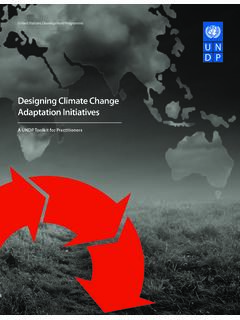Transcription of TOURISM AND MOUNTAIN DEVELOPMENT
1 TOURISM AND MOUNTAIN DEVELOPMENT Vlatko Andonovski, MAKMONTANA Association for Sustainable DEVELOPMENT of MOUNTAIN Regions in Macedonia International Symposium on MOUNTAIN Economy Guizhou University of Finance and Economics (GUFE) Guiyang PRC 6-8 May 2014 The importance of TOURISM for mountains TOURISM is important because it is the world s largest service sector industry in terms of international trade. The annual global turnover is US$ 444 billion, which exceeds the combined Gross National Product of the world s 55 poorest countries. The importance of TOURISM for mountains Many tourist destinations are located in MOUNTAIN regions. About 15 20% of the tourist industry ,or US$ 70 90 billion per year, is accounted for by MOUNTAIN TOURISM .
2 The Alps alone account for an estimated 7-10% of annual global TOURISM turnover. Long recognized as places of sanctuary and spiritual renewal, mountains will become even more attractive as places of escape in a rapidly urbanizing world. Europe, the EU is the most visited region of the world, accommodating of all international travellers. The importance of TOURISM for mountains The mountains in developed countries (particularly in western Europe) are destinations for mass TOURISM , in which high volume and high output are the norm. For example, in Austria, where TOURISM contributes more than 4 % of the GDP and annual per capita income from TOURISM is EUR 1731 (2011), more than 75 % of the total sales in TOURISM is generated by the alpine TOURISM industry.
3 In contrast CEE (Central and Eastern European countries) has the lowest performance among the European regions, with a share of 20% from all European international arrivals (2012). The importance of TOURISM for mountains TOURISM in the European Alps has become increasingly restricted and regulated, with strict regulations and control of the quality of services and facilities, and environmental measures such as emission and pollution standards and appropriate measures for solid waste disposal and treatment of sewage. In contrast, MOUNTAIN TOURISM in the many other parts of the world has been characterized by unregulated, uncontrolled and haphazard DEVELOPMENT . The importance of TOURISM for mountains MOUNTAIN areas include more than 475 protected areas in 65 countries covering more than 264 million hectares.
4 Additionally, 140 MOUNTAIN areas have been designated as biosphere reserves by the United Nations Educational, Scientific and Cultural Organization (UNESCO). Protected areas include national parks where TOURISM is encouraged and promoted. The importance of TOURISM for mountains In contrast to the generally small contribution of MOUNTAIN regions to national economies, the value of mountains to TOURISM is thus significant. TOURISM offers a great variety of opportunities. Tourist activities include swimming, walking, visiting cities and national parks, skiing, snowboarding, bird-watching, diving, and a number of extreme sports such as bungee jumping, river rafting, paragliding, and mountaineering. Many activities are specific to MOUNTAIN areas, which provide a variety of natural and cultural settings.
5 The importance of TOURISM for mountains Mountains are highly diverse. Climatic zones are condensed over distances of a few kilometres. On a single MOUNTAIN , one can experience a tropical climate at the base, a temperate zone at medium altitudes followed by alpine conditions higher up, and finally an arctic environment with snow and glaciers on the highest peaks. Biodiversity is also impressive. To give one example, Mount Kinabalu on the island of Borneo in Southeast Asia is estimated to harbour over 4000 plant species, more than one-quarter of all the species in the entire USA. The specificity of mountains for global TOURISM DEVELOPMENT The promotion of TOURISM in mountains is based on special features that are attractive for TOURISM : clean, cool air, the varied topography, scenic beauty of mountains and cultural landscapes.
6 There are also many diverse natural landscapes and resources, the local traditions, and simple lifestyles even if these are sometimes perceived as such only by tourists. There are the inherent dangers or challenges which attract some daring tourists, and particular MOUNTAIN arenas for special sports and leisure activities. And not least of all, mountains have specific qualities that are conducive to health and wellness TOURISM and activities that focus on contemplation and meditation. The specificity of mountains for global TOURISM DEVELOPMENT In the past couple of decades a new kind of TOURISM has caught on, characterized by more attention to nature. This form of TOURISM , more respectful of conservation of natural resources, helped to raise the awareness about the enormous value of the MOUNTAIN areas.
7 The ecotourism dynamics had also an impact on MOUNTAIN economies, especially giving origin to a series of micro accommodation structures like farm holidays, country houses and B&B (Bed & Breakfast). A network of hospitality solutions following traditional criteria, based on more awareness regarding landscape protection and respectful of artistic and natural beauty, has been developed in some MOUNTAIN areas. The specificity of mountains for global TOURISM DEVELOPMENT MOUNTAIN regions with ecotourism potential in Asia: -Himalaya, Hindu Kush, Karakoram and Pamir Main destinations include areas around Nanga Parbat (Pakistan), Ladakh Kulu-Kangara, Garhwal, Har ki doon (India), Everest & Annpunrna (Nepal) -Northern hills of Thailand (Chiangmai and Chiangrai provinces) -Highlands of China (Yunnan and Fujian provinces) and Korea The specificity of mountains for global TOURISM DEVELOPMENT The latest trends in the MOUNTAIN TOURISM in terms of marketing and DEVELOPMENT (Morrison 2010).
8 MarketingTrends DEVELOPMENT Trends Market diversification More packaging and programming Increasing varietyof recreational activities More attention to off-peak seasons Greater emphasis on fitness and health Expanding partnerships and co-operation Internet marketing now the most important channel More sophisticated branding of MOUNTAIN destinations DEVELOPMENT for all-season use Increasing investment in new recreational activities DEVELOPMENT of specialized and boutique resorts More real estate DEVELOPMENT projects Increasing corporate consolidations; the rise of resort chains Greater attention being given to sustainability concerns Community involvement getting more attention The impacts of TOURISM on mountains The impacts of TOURISM on mountains TOURISM affects mountains in many ways.
9 Economically, tourist resorts in mountains directly depend on their customers. In addition, there are direct and indirect benefits to many sectors and communities inside and outside the resort areas. However, a considerable share of TOURISM revenue leaks to areas outside the mountains. In addition, tourist activities have biophysical impacts. For example, paths and ski-runs may modify sensitive alpine areas; tourists have well-known impacts along MOUNTAIN trails; and wildlife may be disturbed. On the social and cultural side, tourists may disrupt traditions, influence MOUNTAIN communities by their numbers and lifestyles, and attract service providers from outside the mountains to become permanent residents in MOUNTAIN resorts.
10 These negative impacts have to be counterbalanced against positive influences, including economic benefits. The impacts of TOURISM on mountains Environmental impacts The quality of the environment, both natural and man-made, is essential to MOUNTAIN TOURISM . However, TOURISM 's relationship with the environment is complex. It involves many activities that can have adverse environmental effects. Many of these impacts are linked with the construction of: -roads and airports, and - TOURISM facilities (resorts, hotels, restaurants, shops, golf courses and marinas). The negative impacts can gradually destroy the environmental resources on which it depends. Also various emissions can pollute or degrade the environment.

















